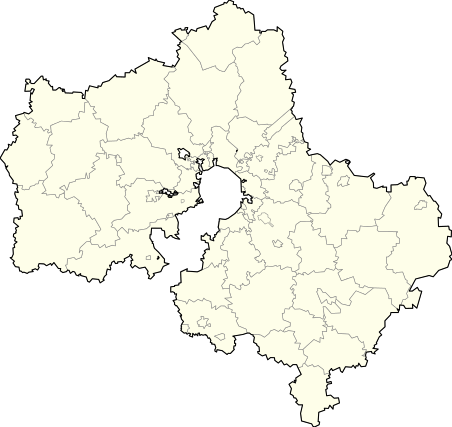Elektrogorsk
| Elektrogorsk (English) Электрогорск (Russian) | |
|---|---|
| - Town[1] - | |
|
| |
.svg.png) Location of Moscow Oblast in Russia | |
 Elektrogorsk | |
|
| |
.png) | |
|
| |
| Administrative status (as of January 2013) | |
| Country | Russia |
| Federal subject | Moscow Oblast[1] |
| Administratively subordinated to | Elektrogorsk Town Under Oblast Jurisdiction[1] |
| Administrative center of | Elektrogorsk Town Under Oblast Jurisdiction[1] |
| Municipal status (as of December 2010) | |
| Urban okrug | Elektrogorsk Urban Okrug[2] |
| Administrative center of | Elektrogorsk Urban Okrug[2] |
| Statistics | |
| Population (2010 Census) | 22,480 inhabitants[3] |
| Time zone | MSK (UTC+03:00)[4] |
| Founded | 1912 |
| Town status since | 1946 |
| Elektrogorsk on Wikimedia Commons | |
Elektrogorsk (Russian: Электрого́рск) is a town in Moscow Oblast, Russia, located 75 kilometers (47 mi) east from Moscow. Population: 22,480 (2010 Census);[3] 20,353 (2002 Census);[5] 18,391 (1989 Census).[6]
History
Elektrogorsk was founded in 1912 due to the construction of the first big peat-fired thermal power station in Russia, which would be called Elektroperedacha ("Электропередача", lit. "electric power transmission"). The settlement was named after the power station. In 1946, it was granted town status and renamed Elektrogorsk. It has a highly variable climate ranging from −30 °C (−22 °F) in the winter up to 25 °C (77 °F) in the summer.
Administrative and municipal status
Within the administrative divisions framework, it is incorporated as Elektrogorsk Town Under Oblast Jurisdiction—an administrative unit with the status equal to that of the districts.[1] As a municipal division, Elektrogorsk Town Under Oblast Jurisdiction is incorporated as Elektrogorsk Urban Okrug.[2]
References
Notes
- 1 2 3 4 5 Law #11/2013-OZ
- 1 2 3 Law #131/2004-OZ
- 1 2 Russian Federal State Statistics Service (2011). "Всероссийская перепись населения 2010 года. Том 1" [2010 All-Russian Population Census, vol. 1]. Всероссийская перепись населения 2010 года (2010 All-Russia Population Census) (in Russian). Federal State Statistics Service. Retrieved June 29, 2012.
- ↑ Правительство Российской Федерации. Федеральный закон №107-ФЗ от 3 июня 2011 г. «Об исчислении времени», в ред. Федерального закона №271-ФЗ от 03 июля 2016 г. «О внесении изменений в Федеральный закон "Об исчислении времени"». Вступил в силу по истечении шестидесяти дней после дня официального опубликования (6 августа 2011 г.). Опубликован: "Российская газета", №120, 6 июня 2011 г. (Government of the Russian Federation. Federal Law #107-FZ of June 31, 2011 On Calculating Time, as amended by the Federal Law #271-FZ of July 03, 2016 On Amending Federal Law "On Calculating Time". Effective as of after sixty days following the day of the official publication.).
- ↑ Russian Federal State Statistics Service (May 21, 2004). "Численность населения России, субъектов Российской Федерации в составе федеральных округов, районов, городских поселений, сельских населённых пунктов – районных центров и сельских населённых пунктов с населением 3 тысячи и более человек" [Population of Russia, Its Federal Districts, Federal Subjects, Districts, Urban Localities, Rural Localities—Administrative Centers, and Rural Localities with Population of Over 3,000] (XLS). Всероссийская перепись населения 2002 года [All-Russia Population Census of 2002] (in Russian). Retrieved August 9, 2014.
- ↑ Demoscope Weekly (1989). "Всесоюзная перепись населения 1989 г. Численность наличного населения союзных и автономных республик, автономных областей и округов, краёв, областей, районов, городских поселений и сёл-райцентров" [All Union Population Census of 1989: Present Population of Union and Autonomous Republics, Autonomous Oblasts and Okrugs, Krais, Oblasts, Districts, Urban Settlements, and Villages Serving as District Administrative Centers]. Всесоюзная перепись населения 1989 года [All-Union Population Census of 1989] (in Russian). Институт демографии Национального исследовательского университета: Высшая школа экономики [Institute of Demography at the National Research University: Higher School of Economics]. Retrieved August 9, 2014.
Sources
- Московская областная Дума. Закон №11/2013-ОЗ от 31 января 2013 г. «Об административно-территориальном устройстве Московской области», в ред. Закона №72/2015-ОЗ от 5 мая 2015 г. «Об отнесении города Озёры Озёрского района Московской области к категории города областного подчинения Московской области, упразднении Озёрского района Московской области и внесении изменений в Закон Московской области "Об административно-территориальном устройстве Московской области"». Вступил в силу на следующий день после официального опубликования (13 января 2013 г.). Опубликован: "Ежедневные Новости. Подмосковье", №24, 12 февраля 2013 г. (Moscow Oblast Duma. Law #11/2013-OZ of January 31, 2013 On the Administrative-Territorial Structure of Moscow Oblast, as amended by the Law #72/2015-OZ of May 5, 2015 On Re-Classifying the Town of Ozyory in Ozyorsky District of Moscow Oblast as the Town Under Oblast Jurisdiction, on Abolishing Ozyorsky District of Moscow Oblast, and on Amending the Law of Moscow Oblast "On the Administrative-Territorial Structure of Moscow Oblast". Effective as of the day following the day of the official publication (January 13, 2013).).
- Московская областная Дума. Закон №131/2004-ОЗ от 29 октября 2004 г. «О статусе и границе городского округа Электрогорск», в ред. Закона №155/2010-ОЗ от 10 декабря 2010 г «О внесении изменений в Закон Московской области "О статусе и границе городского округа Электрогорск"». Вступил в силу со дня официального опубликования. Опубликован: "Ежедневные Новости. Подмосковье", №213, 10 ноября 2004 г. (Moscow Oblast Duma. Law #131/2004-OZ of October 29, 2004 On the Status and the Border of Elektrogorsk Urban Okrug, as amended by the Law #155/2010-OZ of December 10, 2010 On Amending the Law of Moscow Oblast "On the Status and the Border of Elektrogorsk Urban Okrug". Effective as of the day of the official publication.).